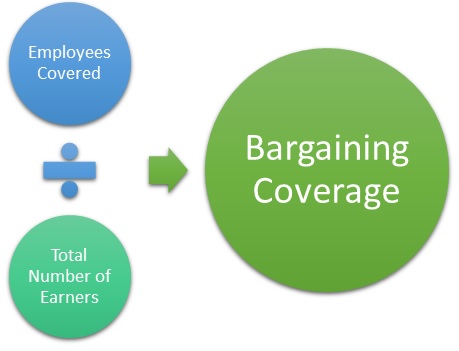- Business Concepts ›
- Human Resources (HR) ›
- Bargaining Coverage
Bargaining Coverage
Definition, Importance & Example
This article covers meaning & overview of Bargaining Coverage from HRM perspective.
What is meant by Bargaining Coverage?
Bargaining coverage indicates the extent to which collective bargaining in collective discussions are fruitful in influencing the terms of workers’ employment. Bargaining coverage is given by the number of employees covered by the collective agreement, divided by the total number of wage and salary-earners.
Ideally bargaining coverage rate should be higher than the union membership rate, because collective bargaining agreements also protect the non-members of the union in a place that is highly unionized. If the bargaining coverage is low it shows that the union is weak and has low bargaining power. It means that individuals will be better off bargaining individually for better pay, compensation, working conditions and benefits rather than bargaining collectively.
Formula for Bargaining Coverage
The formula is given by:
Bargaining Coverage = Employee covered by collective agreement / Total number of wage earners

Read More
Importance of Bargaining Coverage
It is important indicator to know the performance of the trade union and to know the bargaining power of the trade union. If an organization has multiple trade unions and is highly unionized then bargaining coverage helps to find out which trade union is more influential as compared to the other trade unions in the organization. It is affected by whether sectoral collective bargaining is encouraged or enterprise bargaining.
Advantages of Bargaining Coverage
Some advantages of are:
1. It helps to measure the effectiveness of a Trade Union and its bargaining abilities
2. Employees can make informed decisions as to which trade union to support, which would be able to influence the terms of employment and give better compensation and benefits.
Example of Bargaining Coverage
Consider an agreement in a factory of 5,000 employees, then the agreement covers about 2,300 employees then the bargaining coverage is 2300/5000 = 0.46. Another agreement from another trade union for the same 5,000 employees covers about 3,500 employees then the bargaining coverage for that agreement is 3,500/5,000 =0.70. Clearly, the 2nd agreement has a greater bargaining coverage and the trade union that made this decision has greater influence over agreements and should ideally receive the support of most of the employees working in the factory as the 2nd trade union is more influential and is able to cover more employees of a factory.
Hence, this concludes the definition of Bargaining Coverage along with its overview.
This article has been researched & authored by the Business Concepts Team which comprises of MBA students, management professionals, and industry experts. It has been reviewed & published by the MBA Skool Team. The content on MBA Skool has been created for educational & academic purpose only.
Browse the definition and meaning of more similar terms. The Management Dictionary covers over 1800 business concepts from 5 categories.
Continue Reading:
What is MBA Skool?About Us
MBA Skool is a Knowledge Resource for Management Students, Aspirants & Professionals.
Business Courses
Quizzes & Skills
Quizzes test your expertise in business and Skill tests evaluate your management traits
Related Content
All Business Sections
Write for Us